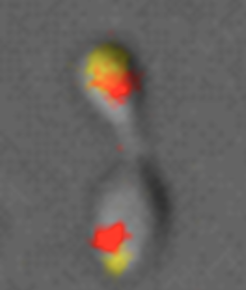Hyphomonas neptunium

Chromosome segregation in H. neptunium. Shown is an S-phase cell carrying fluorescent labels attached to two origin-proximal loci.
To date, cell growth, chromosome segregation, and cell division have, by and large, only been studied in bacteria that divide by binary fission. To expand our knowledge of the mechanisms that govern the spatiotemporal organization of bacterial cells, we have recently established the stalked budding bacterium Hyphomonas neptunium as a new model system in our group.
H. neptunium is a close relative of C. crescentus that proliferates by a unique budding mechanisms in which daughter cells are released from the tip of a long stalk emanating from the mother cell body. Importantly, it possesses many of the regulatory components known to mediate cell growth and differentiation in C. crescentus. This common design makes it relatively straightforward to obtain a general understanding of the system, thereby greatly facilitating studies of its striking distinctive features. Having established a comprehensive toolbox for the genetic manipulation of H. neptunium (Jung et al., 2015), we have now started to study the mechanism of budding, a growth mode that is common among bacteria but still poorly understood. Another intriguing questions concerns the way in which the replicated chromosome is transported through the stalk structure that connects the mother cell body with the bud cell compartment. Preliminary data suggest a novel two-step process reminiscent of eukaryotic mitosis, in which chromosomal DNA is first fully replicated and segregated within the mother cell, followed by rapid translocation of one sister chromosome into the nascent bud (Jung et al., 2019). Finally, we are currently analyzing the mechanisms that control the highly asymmetric positioning of the divisome at the stalk-bud junction, a process that does not involve any of the regulatory systems known so far.
